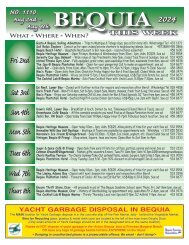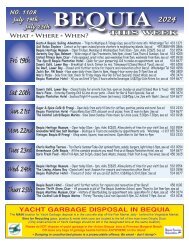Caribbean Compass Yachting Magazine - October 2021
Welcome to Caribbean Compass, the most widely-read boating publication in the Caribbean! THE MOST NEWS YOU CAN USE - feature articles on cruising destinations, regattas, environment, events...
Welcome to Caribbean Compass, the most widely-read boating publication in the Caribbean! THE MOST NEWS YOU CAN USE - feature articles on cruising destinations, regattas, environment, events...
Create successful ePaper yourself
Turn your PDF publications into a flip-book with our unique Google optimized e-Paper software.
DESTINATIONS<br />
LES ILES DE LA PETIT-TERRE<br />
by Chris Doyle<br />
OCTOBER <strong>2021</strong> CARIBBEAN COMPASS PAGE 20<br />
Insets from left: Moorings are in the deepest part of the lagoon.<br />
West of the lighthouse, Terre de Bas is densely wooded. We got lost in the maze of old hunting trails.<br />
It isn’t prettiest reef you will find, but it attracts abundant sea life. Main image: Terre de Haut is a valuable bird nesting site, so access is limited to a tiny beach.<br />
W<br />
hen I started writing The Cruising Guide to<br />
the Leeward Islands a quarter of a century<br />
ago, I heard about les Iles de la Petit-Terre. It<br />
was portrayed as a magical place: two uninhabited<br />
islands on the edge of the world, a palm-backed beach,<br />
a good anchoring area with ten to 12 feet of water, and<br />
a lovely reef. But — and it was big but — it was subject<br />
to swells and you had to cross a hard dead-coral bar of<br />
only seven or eight feet, making it, I was told, dangerous<br />
to approach in a boat like mine, which in those days was<br />
the CSY41 Helos, which had a six-and-a-half-foot draft.<br />
I heeded the warnings for a year or two, but I was<br />
intensely curious so when conditions were reasonably<br />
calm and I had my good friend Paul on board, we<br />
decided to investigate.<br />
It is fun sailing to les Iles de la Petit-Terre because<br />
they are very low lying, and the first thing you see is a<br />
lighthouse sticking up in the middle of the ocean. Once<br />
you get closer it is easy to make out the two islands. We<br />
sailed towards the entrance till we were in water about<br />
ten feet deep, and then dropped the anchor in the<br />
gentle swell outside the bar. It is not often flat calm, but<br />
there were no big or breaking waves. We launched the<br />
dinghy and explored with a hand-held GPS and lead<br />
line, and measured the depths on the bar. In this we<br />
were pleasantly surprised — it looked like the best<br />
approach had depths of at least eight feet.<br />
We returned to Helos, raised the anchor, motored in,<br />
and anchored in the lagoon. In those days it was less<br />
visited and not yet an active marine park, though there<br />
was already a small day-charter trade of catamarans<br />
coming over from Guadeloupe. We walked all round the<br />
smaller island, Terre de Haut, and up to the lighthouse<br />
and the eastern cliffs on Terre de Bas. We snorkeled all<br />
over, taking the dinghy to the outer part of the reef.<br />
I have visited nearly every other year since then and<br />
was happy to see it become an active marine park.<br />
This has come with moorings, which are in the deepest<br />
part of the lagoon. The ones for visitors are spaced in<br />
an easterly line and close together so they can get the<br />
most boats in. They have a few extra moorings for the<br />
big day-charter boats, which get a bit more space.<br />
As waves break over the outside reef they get<br />
funneled into the narrower cut between the islands,<br />
creating a constant current of about one knot flowing<br />
east to west. I have, on at least one occasion, found<br />
this challenging when trying to pick up a mooring<br />
single-handed, and am happy that, when it was clear<br />
that I was failing, a French yachtsman came over with<br />
a dinghy to give me hand.<br />
With the park came protective regulations. You can<br />
explore all over Terre de Bas, but Terre de Haut is a<br />
valuable bird nesting site, so access is limited to a tiny<br />
beach opposite the moorings that you are allowed to<br />
swim to (no dinghies, and good luck with the current).<br />
But exploring further ashore is not permitted. Dinghy<br />
use is now also restricted: you can only go from your<br />
boat to the main beach in Terre de Bas, where you<br />
should tie up to a mooring and wade ashore. When that<br />
regulation first came in, I wondered how I could possibly<br />
get out towards the entrance with all that current<br />
flowing through. In the end it proved not to be that hard.<br />
You swim out close to the land, which keeps you out of<br />
the current, and then when ready to come back, you<br />
head into the current and let it sweep you home.<br />
The seabed includes old, dead coral beaten flat, large<br />
areas of standing but mainly dead coral, with plenty of<br />
holes and hiding spots for fish, some live coral, and<br />
various seagrass beds. It is not the freshest and<br />
prettiest reef you will find, but, being in the middle of<br />
nowhere, with open sea pouring though, it attracts<br />
amazing sea life including many turtles, rays, and<br />
nurse sharks, and I know of nowhere else that has<br />
such an abundance of interesting fish. Since the water<br />
is both shallow and clear you find yourself getting up<br />
close to these with ease. One night I put a light shining<br />
on the water from the back of my boat and it soon<br />
attracted some huge fish. I think they were probably<br />
tarpon. The marine park does now sometimes restrict<br />
snorkeling access in some areas with a line of buoys.<br />
LEXI FISHER

















